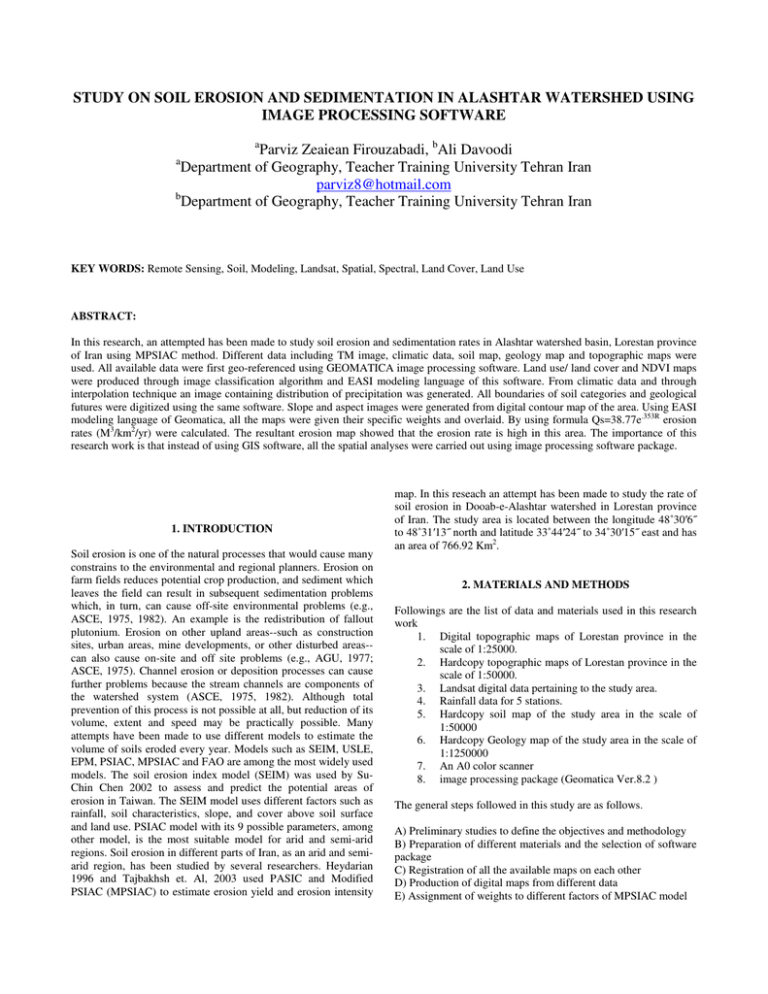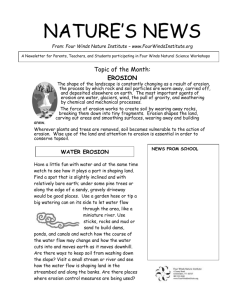STUDY ON SOIL EROSION AND SEDIMENTATION IN ALASHTAR WATERSHED USING
advertisement

STUDY ON SOIL EROSION AND SEDIMENTATION IN ALASHTAR WATERSHED USING IMAGE PROCESSING SOFTWARE a Parviz Zeaiean Firouzabadi, bAli Davoodi Department of Geography, Teacher Training University Tehran Iran parviz8@hotmail.com b Department of Geography, Teacher Training University Tehran Iran a KEY WORDS: Remote Sensing, Soil, Modeling, Landsat, Spatial, Spectral, Land Cover, Land Use ABSTRACT: In this research, an attempted has been made to study soil erosion and sedimentation rates in Alashtar watershed basin, Lorestan province of Iran using MPSIAC method. Different data including TM image, climatic data, soil map, geology map and topographic maps were used. All available data were first geo-referenced using GEOMATICA image processing software. Land use/ land cover and NDVI maps were produced through image classification algorithm and EASI modeling language of this software. From climatic data and through interpolation technique an image containing distribution of precipitation was generated. All boundaries of soil categories and geological futures were digitized using the same software. Slope and aspect images were generated from digital contour map of the area. Using EASI modeling language of Geomatica, all the maps were given their specific weights and overlaid. By using formula Qs=38.77e.353R erosion rates (M3/km2/yr) were calculated. The resultant erosion map showed that the erosion rate is high in this area. The importance of this research work is that instead of using GIS software, all the spatial analyses were carried out using image processing software package. 1. INTRODUCTION Soil erosion is one of the natural processes that would cause many constrains to the environmental and regional planners. Erosion on farm fields reduces potential crop production, and sediment which leaves the field can result in subsequent sedimentation problems which, in turn, can cause off-site environmental problems (e.g., ASCE, 1975, 1982). An example is the redistribution of fallout plutonium. Erosion on other upland areas--such as construction sites, urban areas, mine developments, or other disturbed areas-can also cause on-site and off site problems (e.g., AGU, 1977; ASCE, 1975). Channel erosion or deposition processes can cause further problems because the stream channels are components of the watershed system (ASCE, 1975, 1982). Although total prevention of this process is not possible at all, but reduction of its volume, extent and speed may be practically possible. Many attempts have been made to use different models to estimate the volume of soils eroded every year. Models such as SEIM, USLE, EPM, PSIAC, MPSIAC and FAO are among the most widely used models. The soil erosion index model (SEIM) was used by SuChin Chen 2002 to assess and predict the potential areas of erosion in Taiwan. The SEIM model uses different factors such as rainfall, soil characteristics, slope, and cover above soil surface and land use. PSIAC model with its 9 possible parameters, among other model, is the most suitable model for arid and semi-arid regions. Soil erosion in different parts of Iran, as an arid and semiarid region, has been studied by several researchers. Heydarian 1996 and Tajbakhsh et. Al, 2003 used PASIC and Modified PSIAC (MPSIAC) to estimate erosion yield and erosion intensity map. In this reseach an attempt has been made to study the rate of soil erosion in Dooab-e-Alashtar watershed in Lorestan province of Iran. The study area is located between the longitude 48˚30 6˝ to 48˚31 13˝ north and latitude 33˚44 24˝ to 34˚30 15˝ east and has an area of 766.92 Km2. 2. MATERIALS AND METHODS Followings are the list of data and materials used in this research work 1. Digital topographic maps of Lorestan province in the scale of 1:25000. 2. Hardcopy topographic maps of Lorestan province in the scale of 1:50000. 3. Landsat digital data pertaining to the study area. 4. Rainfall data for 5 stations. 5. Hardcopy soil map of the study area in the scale of 1:50000 6. Hardcopy Geology map of the study area in the scale of 1:1250000 7. An A0 color scanner 8. image processing package (Geomatica Ver.8.2 ) The general steps followed in this study are as follows. A) Preliminary studies to define the objectives and methodology B) Preparation of different materials and the selection of software package C) Registration of all the available maps on each other D) Production of digital maps from different data E) Assignment of weights to different factors of MPSIAC model F) Calculation of R (sum of the effective factors) and Q values for each location G) Categorizing different erosion levels Based on factors needed to establish the MPSIAC soil erosion model, using an A0 color scanner all the hard copy maps were scanned and saved in computer with jpeg format. Hardcopy topographic sheets were geo-referenced and joined as mosaic in UTM map projection system using GCPworks module of Geomatica software package (figure 1). All the other hardcopy maps and satellite data were then registered on the same image and the boundaries of the map categories were then digitized and saved in the same file. The contour lines of the digital topographic maps were simply imported and saved in the mosaic file and used to generate Digital Elevation Model (DEM) of the area. Through watershed and vector utility of Xpace module of Geomatica, slope, aspect and watershed sub-basins images were produced. After statistical analysis of rainfall data, they were used to generate digital rainfall model using interpolation techniques. Satellite data (figure 2) used to produce two inputs for the model. General land use map of the study area was produced using maximum likelihood classification algorithm. And land cover map was produced using EASI modeling language of Geomatica software based on normalized vegetation difference index (NDVI). Run off map was also generated. By field survey, and based on BLM method the erosion condition map was created. The gully erosion factor in MPSIAC model was created through SSFG in the BLM method. Figure1. Mosaic map of the study area X1 through X9 are geology, soil, climate, runoff, topology, land cover land use surface erosion and gully erosion factors respectively. R=sum of the effective factors Q=38.77e0.0353R Q=total sediment yield in m3/km2/yr. Through this procedure, the final map that shows different level of erosion in this area was produced figure 3. Erosion rate Less Medium High Very high Figure3. Final erosion map 3. RESULTS AND DISCUSSIONS As it is clear from the figure3, in this area the erosion process is in its high rate in the north. That is because of the geology and steep slopes and less vegetation cover of that area. In eastern and southeastern part of this area, due to the factors like slope, less dept soils, feeding chattels, cultivation in the slopes and the presence of marl formation, the erosion rate is high. In south due to agricultural activities and fewer slopes the erosion rates are very less. Due to high sediment rates in this part of Iran, watershed management plans should be actively defined and implemented. Results of this study show that remote sensing data in conjunction with image processing software packages could be useful to estimate erosion rate in watershed sub-basin area. MPSIAC model has shown to be a useful way of estimation total sediment yield for arid and semi-arid regions and powerful image processing software packages like Geomatica could be efficiently used for such multi-layers modeling problems. In the cost and time point of view, doing such tasks is less time consuming and cost effective in comparison with traditional method of soil erosion studies. The importance of this research work is that instead of using GIS software, all the spatial analyses were carried out using image processing software package REFERENCES Figure2. Mosaic TM image of the area After the preparation and assignment of relative importance weights of all effective factors in MPSIAC model, based on the following equations and using modeling language of Geomatica software package, the final erosion map was produced (figure 3). R=X1+ 16.67X2 + 0.2X3 + 0.3X4 + 0.33X5 + 0.2X6+ [20-0.2X7] + 0.25X8 +1.67X9 American Geophysical Union, 1977, Research Needs in Erosion and Sedimentation, Report of the Committee on Erosion and Sedimentation, Hydrology Section, Trans. Am. Geophys. Union, 58(12): 1075-1083. American Society of Civil Engineers, 1975, Sedimentation Engineering, ASCE Manuals and Reports on Engineering Practice, No. 54, V. A. Vanoni (Ed.), ASCE, New York. American Society of Civil Engineers, 1982, Relationships between morphology of small streams and sediment yield, Report of the Task Committee on Sedimentation of the Hydraulics Division, J. Hydraul. Div., Am. Soc. Civ. Eng., 108(HY11): 1328 1365. Su-Chin Chen, 2002. "The Assessment of soil erosion potential by SEIM in Taiwan", Warsaw, http://kiki.baw.de/ conferences/ ICHE/ 2002-warsaw/ARTICLES/ PDF/242.pdf. Heydarian,S.A.1996. " Assessment of erosion in Mountain regions", http://www.gisdevelopment.net/aars/acrs/ 1996/ ts10/ ts10006pf.htm Tajbakhsh, S.M., and Memarian, 2003 H.. "the sediment yield potential estimation of Faridabad and Kordian watersheds using MPSIAC model in GIS framework", http://www.gisdevelopment.net/application/agriculture/soil/ma031 56pf.htm







